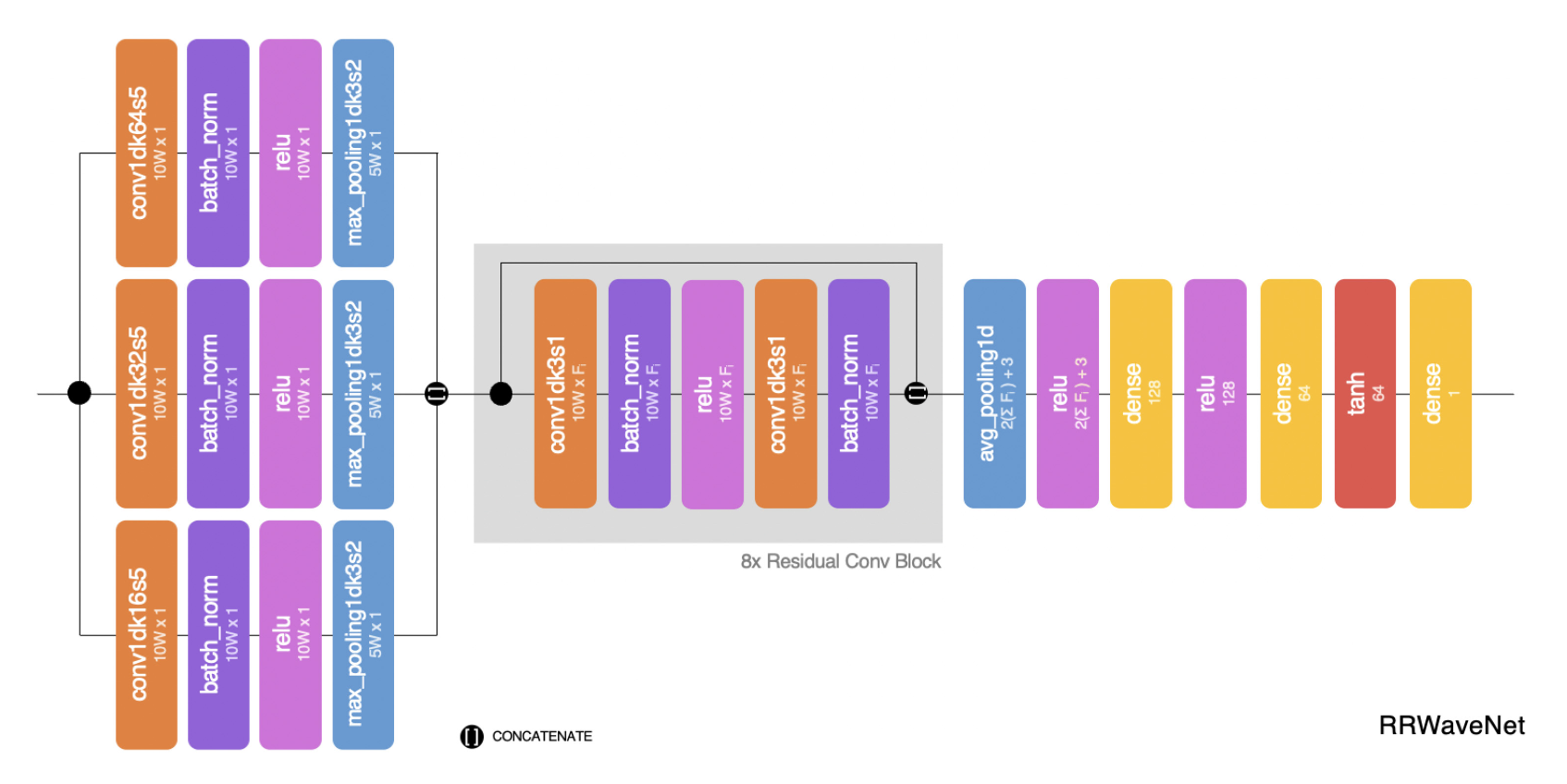Official implementation of RRWaveNet from IEEE Internet of Things Journal (IOTJ).
Paper authors: Pongpanut Osathitporn, Guntitat Sawadwuthikul, Punnawish Thuwajit, Kawisara Ueafuea, Thee Mateepithaktham, Narin Kunaseth, Tanut Choksatchawathi, Proadpran Punyabukkana, Emmanuel Mignot, and Theerawit Wilaiprasitporn
Figure: Composed of three modules, RRWaveNet involves the multiscale convolution (left), the deep spatial-temporal residual blocks (center), and the RR estimator (right). Each layer’s title is abbreviated at the top row for simplicity and the shape of the output tensor after each layer is specified below its title. For example, conv1dk32s5, the leftmost layer in the center module, refers to a 1-D-convolutional layer with a kernel of size 32 and a stride of 5, resulting a (10 W, 1) tensor.
Respiratory rate (RR) is an important biomarker as RR changes can reflect severe medical events,
such as heart disease, lung disease, and sleep disorders. Unfortunately, standard manual RR counting
is prone to human error and cannot be performed continuously. This study proposes a method for
continuously estimating RR, RRWaveNet. The method is a compact end-to-end deep learning model which
does not require feature engineering and can use low-cost raw photoplethysmography (PPG) as input
signal. RRWaveNet was tested subject-independently and compared to baseline in four data sets
(BIDMC, CapnoBase, WESAD, and SensAI) and using three window sizes (16, 32, and 64 s). RRWaveNet
outperformed current state-of-the-art methods with mean absolute errors at an optimal window size of
# Clone the repository
git clone https://github.com/IoBT-VISTEC/RRWaveNet
# Install dependencies. Recommend to use a separate environment.
pip install -r requirements.txtThe data must be accessible at /path/to/this/repo/data/{dataset_name}/{file}_{winsize}.npy where
file must be both X and RR (CO2 is also required to run RespNet). For example:
data
└── bidmc
├── CO2_16.npy
├── RR_16.npy
└── X_16.npy
The structure of each X_*.npy and CO2_*.npy file should
- Be iterable
- Consist of
n_subjectselements, all iterable - Each of the
n_subjectsshould containn_windowselements - Each of the
n_windowselements should be a 1Dnp.ndarraywhich contains the data of PPG or CO2 of 1 minute in length with a shape of(60 * sampling_rate, )
For RR_*.npy files, they should
- Be iterable
- Consist of
n_subjectselements, all iterable - Each of the
n_subjectsshould containn_windowsfloats, each number indicating the BPM of the corresponding window
# Example
x = np.load(f"data/bidmc/X_16.npy", allow_pickle=True)
y = np.load(f"data/bidmc/RR_16.npy", allow_pickle=True)
print(len(x)) # 50
print(len(x[0])) # 141
print(len(x[1])) # 150
print(type(x[0][0])) # <class 'numpy.ndarray'>
print(x[0][0].shape) # (2000,)
print(len(y)) # 50
print(len(y[0])) # 141
print(type(y[0][0])) # <class 'numpy.float64'>python main.py --model [model_name] --dataset [dataset_name] --winsize [window_size]Valid options are
--model:DeepLearning,RespNet,RespWatch, orRRWaveNet.--dataset: Depends on the available data you prepared, we usedbidmc,capnobase, andwesadfor the experiments in the paper.--winsize: Depends on the available data you prepared, we used16,32, and64for our experiments.
The implementation of AR is not provided in this repository. We recommend the reproducing steps as defined in the original paper.
When the experiment finishes, the average and standard deviation of the MAEs across all subjects will be printed.
Should you encounter any issue or bug, please create an issue with details here.
Plaintext
P. Osathitporn et al., "RRWaveNet: A Compact End-to-End Multiscale Residual CNN for Robust PPG Respiratory Rate Estimation," in IEEE Internet of Things Journal, vol. 10, no. 18, pp. 15943-15952, 15 Sept.15, 2023, doi: 10.1109/JIOT.2023.3265980.
BibTeX
@ARTICLE{10098530,
author={Osathitporn, Pongpanut and Sawadwuthikul, Guntitat and Thuwajit, Punnawish and Ueafuea, Kawisara and Mateepithaktham, Thee and Kunaseth, Narin and Choksatchawathi, Tanut and Punyabukkana, Proadpran and Mignot, Emmanuel and Wilaiprasitporn, Theerawit},
journal={IEEE Internet of Things Journal},
title={RRWaveNet: A Compact End-to-End Multiscale Residual CNN for Robust PPG Respiratory Rate Estimation},
year={2023},
volume={10},
number={18},
pages={15943-15952},
doi={10.1109/JIOT.2023.3265980}}
